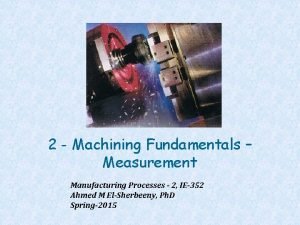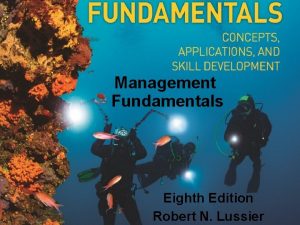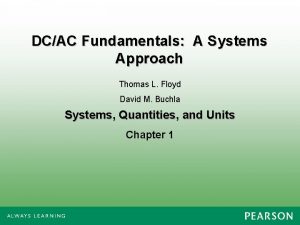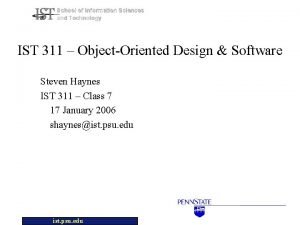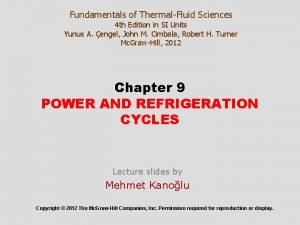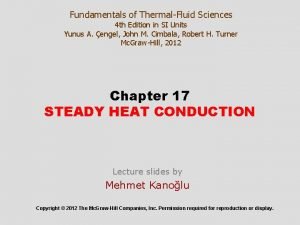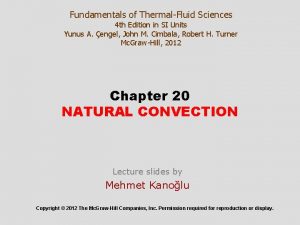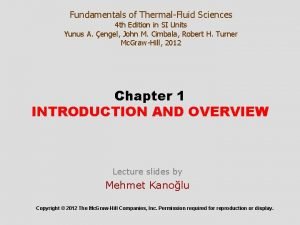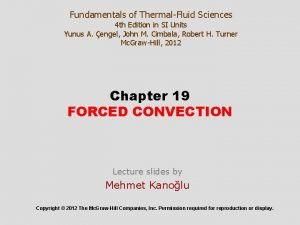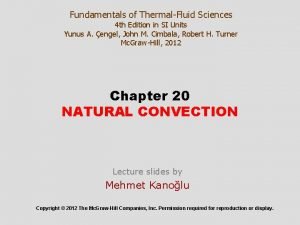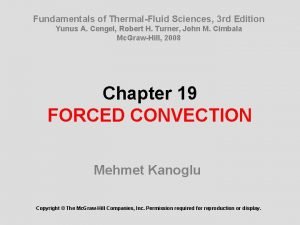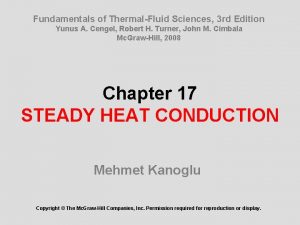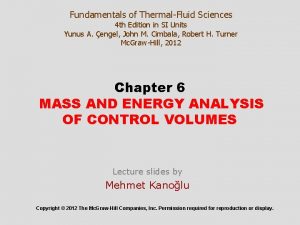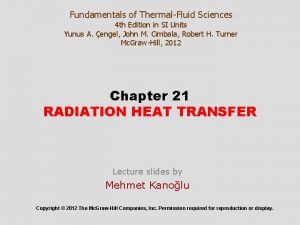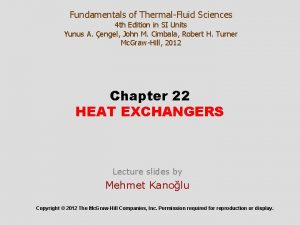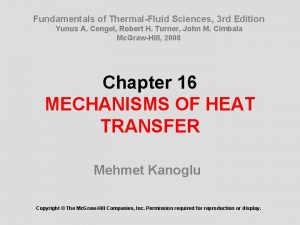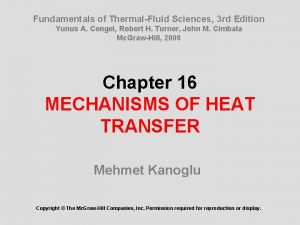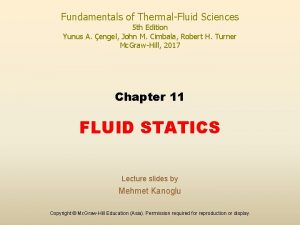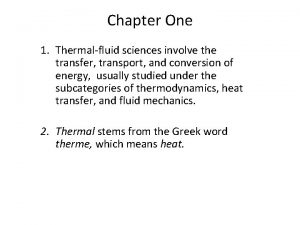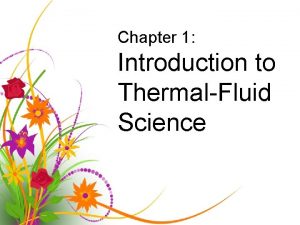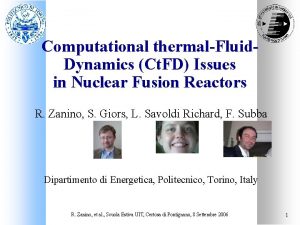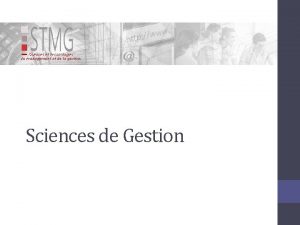Fundamentals of ThermalFluid Sciences 4 th Edition in


























- Slides: 26

Fundamentals of Thermal-Fluid Sciences 4 th Edition in SI Units Yunus A. Çengel, John M. Cimbala, Robert H. Turner Mc. Graw-Hill, 2012 Chapter 2 BASIC CONCEPTS OF THERMODYNAMICS Lecture slides by Mehmet Kanoğlu Copyright © 2012 The Mc. Graw-Hill Companies, Inc. Permission required for reproduction or display.

Objectives • Identify the unique vocabulary associated with thermodynamics through the precise definition of basic concepts to form a sound foundation for the development of the principles of thermodynamics. • Explain the basic concepts of thermodynamics such as system, state postulate, equilibrium, process, and cycle. • Review concepts of temperature, temperature scales, pressure, and absolute and gage pressure. 2

2 -1 SYSTEMS AND CONTROL VOLUMES • • • System: A quantity of matter or a region in space chosen for study. Surroundings: The mass or region outside the system Boundary: The real or imaginary surface that separates the system from its surroundings. The boundary of a system can be fixed or movable. Systems may be considered to be closed or open. Closed system (Control mass): A fixed amount of mass, and no mass can cross its boundary 3

• Open system (control volume): A properly selected region in space. • It usually encloses a device that involves mass flow such as a compressor, turbine, or nozzle. • Both mass and energy can cross the boundary of a control volume. • Control surface: The boundaries of a control volume. It can be real or imaginary. 4

2 -2 PROPERTIES OF A SYSTEM • Property: Any characteristic of a system. • Some familiar properties are pressure P, temperature T, volume V, and mass m. • Properties are considered to be either intensive or extensive. • Intensive properties: Those that are independent of the mass of a system, such as temperature, pressure, and density. • Extensive properties: Those whose values depend on the size— or extent—of the system. • Specific properties: Extensive properties per unit mass. 5

Continuum • Matter is made up of atoms that are widely spaced in the gas phase. Yet it is very convenient to disregard the atomic nature of a substance and view it as a continuous, homogeneous matter with no holes, that is, a continuum. • The continuum idealization allows us to treat properties as point functions and to assume the properties vary continually in space with no jump discontinuities. • This idealization is valid as long as the size of the system we deal with is large relative to the space between the molecules. • This is the case in practically all problems. • In this text we will limit our consideration to substances that can be modeled as a continuum. 6

2 -3 DENSITY AND SPECIFIC GRAVITY Density Specific volume Specific gravity: The ratio of the density of a substance to the density of some standard substance at a specified temperature (usually water at 4°C). Specific weight: The weight of a unit volume of a substance. Density is mass per unit volume; specific volume is volume per unit mass. 7

2 -4 STATE AND EQUILIBRIUM • • Thermodynamics deals with equilibrium states. Equilibrium: A state of balance. In an equilibrium state there are no unbalanced potentials (or driving forces) within the system. Thermal equilibrium: If the temperature is the same throughout the entire system. Mechanical equilibrium: If there is no change in pressure at any point of the system with time. Phase equilibrium: If a system involves two phases and when the mass of each phase reaches an equilibrium level and stays there. Chemical equilibrium: If the chemical composition of a system does not change with time, that is, no chemical reactions occur. 8

The State Postulate • The number of properties required to fix the state of a system is given by the state postulate: ü The state of a simple compressible system is completely specified by two independent, intensive properties. • Simple compressible system: If a system involves no electrical, magnetic, gravitational, motion, and surface tension effects. The state of nitrogen is fixed by two independent, intensive properties. 9

2 -5 PROCESSES AND CYCLES Process: Any change that a system undergoes from one equilibrium state to another. Path: The series of states through which a system passes during a process. To describe a process completely, one should specify the initial and final states, as well as the path it follows, and the interactions with the surroundings. Quasistatic or quasi-equilibrium process: When a process proceeds in such a manner that the system remains infinitesimally close to an equilibrium state at all times. 10

• Process diagrams plotted by employing thermodynamic properties as coordinates are very useful in visualizing the processes. • Some common properties that are used as coordinates are temperature T, pressure P, and volume V (or specific volume v). • The prefix iso- is often used to designate a process for which a particular property remains constant. • Isothermal process: A process during which the temperature T remains constant. • Isobaric process: A process during which the pressure P remains constant. • Isochoric (or isometric) process: A process during which the specific volume v remains constant. • Cycle: A process during which the initial and final states are identical. 11

The Steady-Flow Process • • The term steady implies no change with time. The opposite of steady is unsteady, or transient. A large number of engineering devices operate for long periods of time under the same conditions, and they are classified as steady-flow devices. Steady-flow process: A process during which a fluid flows through a control volume steadily. Steady-flow conditions can be closely approximated by devices that are intended for continuous operation such as turbines, pumps, boilers, condensers, and heat exchangers or power plants or refrigeration systems. During a steadyflow process, fluid properties within the control volume may change with position but not with time. 12

2 -6 TEMPERATURE AND THE ZEROTH LAW OF THERMODYNAMICS • The zeroth law of thermodynamics: If two bodies are in thermal equilibrium with a third body, they are also in thermal equilibrium with each other. • By replacing the third body with a thermometer, the zeroth law can be restated as two bodies are in thermal equilibrium if both have the same temperature reading even if they are not in contact. 13

Temperature Scales • • P versus T plots All temperature scales are based on of the some easily reproducible states such as experimental the freezing and boiling points of water: data obtained the ice point and the steam point. from a constant. Ice point: A mixture of ice and water volume gas that is in equilibrium with air saturated thermometer with vapor at 1 atm pressure (0°C or 32°F). using four different gases Steam point: A mixture of liquid water at different (but and water vapor (with no air) in equilibrium at 1 atm pressure (100°C or low) pressures. 212°F). Celsius scale: in SI unit system Fahrenheit scale: in English unit system Thermodynamic temperature scale: A temperature scale that is independent of the properties of any substance. Kelvin scale (SI) Rankine scale (E) A temperature scale nearly identical to the Kelvin scale is the ideal-gas temperature scale. The temperatures on this scale are measured using a constant-volume gas thermometer. A constant-volume gas thermometer would read -273. 15°C at absolute zero pressure. 14

Comparison of temperature scales. Comparison of magnitudes of various temperature units. • • The reference temperature in the original Kelvin scale was the ice point, 273. 15 K, which is the temperature at which water freezes (or ice melts). The reference point was changed to a much more precisely reproducible point, the triple point of water (the state at which all three phases of water coexist in equilibrium), which is assigned the value 273. 16 K. 15

The International Temperature Scale of 1990 (ITS-90) The International Temperature Scale of 1990 supersedes the International Practical Temperature Scale of 1968 (IPTS-68), 1948 (ITPS-48), and 1927 (ITS 27). The ITS-90 is similar to its predecessors except that it is more refined with updated values of fixed temperatures, has an extended range, and conforms more closely to thermodynamic temperature scale. On this scale, the unit of thermodynamic temperature T is again the kelvin (K), defined as the fraction 1/273. 16 of thermodynamic temperature of the triple point of water, which is sole defining fixed point of both the ITS-90 and the Kelvin scale and is the most important thermometric fixed point used in the calibration of thermometers to ITS-90. The unit of Celsius temperature is the degree Celsius (°C). The ice point remains the same at 0°C (273. 15 K) in both ITS-90 and ITPS-68, but the steam point is 99. 975°C in ITS-90 whereas it was 100. 000°C in IPTS-68. The change is due to precise measurements made by gas thermometry by paying particular attention to the effect of sorption (the impurities in a gas absorbed by the walls of the bulb at the reference temperature being desorbed at higher temperatures, causing the measured gas pressure to increase). 16

2 -7 PRESSURE 68 kg 136 kg Pressure: A normal force exerted by a fluid per unit area Afeet=300 cm 2 0. 23 kgf/cm 2 0. 46 kgf/cm 2 P=68/300=0. 23 kgf/cm 2 The normal stress (or “pressure”) on the feet of a chubby person is much greater than on the feet of a slim person. Some basic pressure gages. 17

• Absolute pressure: The actual pressure at a given position. It is measured relative to absolute vacuum (i. e. , absolute zero pressure). • Gage pressure: The difference between the absolute pressure and the local atmospheric pressure. Most pressure-measuring devices are calibrated to read zero in the atmosphere, and so they indicate gage pressure. • Vacuum pressures: Pressures below atmospheric pressure. Throughout this text, the pressure P will denote absolute pressure unless specified otherwise. 18

Variation of Pressure with Depth When the variation of density with elevation is known 19

In a room filled with a gas, the variation of pressure with height is negligible. Pressure in a liquid at rest increases linearly with distance from the free surface. 20

Pascal’s law: The pressure applied to a confined fluid increases the pressure throughout by the same amount. The area ratio A 2/A 1 is called the ideal mechanical advantage of the hydraulic lift. Lifting of a large weight by a small force by the application of Pascal’s law. 21

2 -8 THE MANOMETER It is commonly used to measure small and moderate pressure differences. A manometer contains one or more fluids such as mercury, water, alcohol, or oil. Measuring the pressure drop across a flow section or a flow device by a differential manometer. The basic manometer. 22

Other Pressure Measurement Devices • Bourdon tube: Consists of a hollow metal tube bent like a hook whose end is closed and connected to a dial indicator needle. • Pressure transducers: Use various techniques to convert the pressure effect to an electrical effect such as a change in voltage, resistance, or capacitance. • Pressure transducers are smaller and faster, and they can be more sensitive, reliable, and precise than their mechanical counterparts. • Strain-gage pressure transducers: Work by having a diaphragm deflect between two chambers open to the pressure inputs. • Piezoelectric transducers: Also called solidstate pressure transducers, work on the principle that an electric potential is generated in a crystalline substance when it is subjected to mechanical pressure. 23

2 -9 THE BAROMETER AND ATMOSPHERIC PRESSURE • Atmospheric pressure is measured by a device called a barometer; thus, the atmospheric pressure is often referred to as the barometric pressure. • A frequently used pressure unit is the standard atmosphere, which is defined as the pressure produced by a column of mercury 760 mm in height at 0°C ( Hg = 13, 595 kg/m 3) under standard gravitational acceleration (g = 9. 807 m/s 2). The length or the cross-sectional area of the tube has no effect on the height of the fluid column of a barometer, provided that the tube diameter is large enough to avoid surface tension (capillary) effects. 24

25

Summary • Systems and control volumes • Properties of a system ü Continuum • Density and specific gravity • State and equilibrium ü The state postulate • Processes and cycles ü The steady-flow process • Temperature and the zeroth law of thermodynamics ü Temperature scales ü ITS-90 • Pressure ü Variation of pressure with depth • The manometer ü Other pressure measurement devices • The barometer and atmospheric pressure 26
 Natural science tok
Natural science tok Computer security fundamentals 4th edition
Computer security fundamentals 4th edition Machining fundamentals 10th edition
Machining fundamentals 10th edition Corporate finance 6th edition
Corporate finance 6th edition Digital fundamentals by floyd 10th edition
Digital fundamentals by floyd 10th edition Fundamentals of information systems 9th edition
Fundamentals of information systems 9th edition The fundamentals of political science research 2nd edition
The fundamentals of political science research 2nd edition Management fundamentals 8th edition
Management fundamentals 8th edition Fundamentals of organizational communication 9th edition
Fundamentals of organizational communication 9th edition Lysanx
Lysanx Floyd digital fundamentals 10th edition pdf
Floyd digital fundamentals 10th edition pdf No slip condition
No slip condition Fundamentals of corporate finance canadian edition
Fundamentals of corporate finance canadian edition Fundamentals of information systems 9th edition
Fundamentals of information systems 9th edition Fundamentals of organizational communication 9th edition
Fundamentals of organizational communication 9th edition Fundamentals of information systems 9th edition
Fundamentals of information systems 9th edition Dc/ac fundamentals 1st edition
Dc/ac fundamentals 1st edition Digital fundamentals answers
Digital fundamentals answers Fundamentals of corporate finance fifth edition
Fundamentals of corporate finance fifth edition Sujata madan
Sujata madan Fundamentals of information systems 9th edition
Fundamentals of information systems 9th edition Fundamentals of heat and mass transfer 4th edition
Fundamentals of heat and mass transfer 4th edition Using mis (10th edition) 10th edition
Using mis (10th edition) 10th edition Using mis (10th edition) 10th edition
Using mis (10th edition) 10th edition Hawaii academy of arts and science
Hawaii academy of arts and science Applied medical sciences
Applied medical sciences College of information sciences and technology
College of information sciences and technology


